- Joined
- Dec 21, 2008
- Messages
- 1,223
- Points
- 0
Preface
Like many of you here, I went gung-ho after seeing a green LP first-hand. At the time, I was pretty much bored with the trillions of <1mW red LPs so I hadn’t really thought about lasers in a long time. Of course, that’s before I discovered LPF and the fact that there were DIYers churning out 300mW reds, not to mention 200mW BRs! So naturally, my first >1mW laser was a green LP and also the basis of my first post here @LPF. Two ~200mW 405nm 6X and three ~300mW 660nm LCC/LOC lasers later and I’m still enchanted by that same green glow that got me into this hobby in the first place
Intro
I don’t know why, exactly, but if a Laser doesn’t fit in my pocket (figuratively speaking), then I’m not all that interested. Having said that, my "Jaynom" Kryton Green is the biggest laser I own atm and I’m always eyeing the smaller builds here at LPF. Thus, as exceptional as they may be, I’m not into “RPL”–like handhelds as much as Dorcy Jr. / Romisen – Ultrafire builds. So of course my eyes lit up when Jay posted his latest build (at that time), his “mini” green kit:
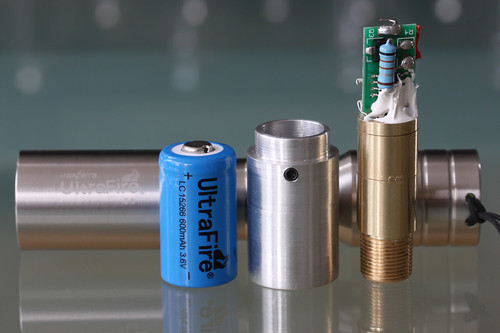
Forget Obi-wan, Jay's the master here
Without a doubt, Jay (aka JayRob, aka badBoyOnBigBlackBike, aka...) is one of the key members of LPF. His contributions, both in Lazor "kits" as well as Lazor-knowhow are just to numerous to mention :beer: For example, the heatsink pictured above, which fits the stainless steel Ultrafire host so perfectly that its really got you :thinking:, is only half of the story. Jay has literally re-bored the host to accommodate the non-standard CR2 battery (standard for said host being a AA or 14500 Li-ion equivalent). I’m not a machinist, but I’ve had the opportunity to mess around with a lathe and it’s harder than it looks - and that was with Aluminum, never mind stainless steel!!! So needless to say, there’s really quite a bit of effort, not to mention experience behind this kit and well worth Jay’s asking price. Did I mention that it’s an awesome-looking host?
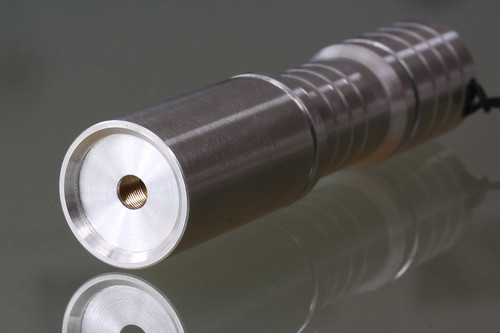
Or, in Jay's words, "schweet!"
(...interesting choice of words, for a badBoyOnBigBlackBike...)
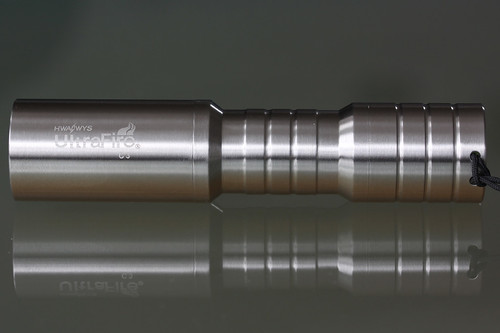
What size module did you say?
Oh well, if it was that easy, Jay wouldn’t be interested. He’s a man always looking for a challenge, be it on his bike or his lathe. In order to make use of the original mini green kit (V1.0 RC), one needed to shorten the typical 65mm green DPSS module. “Ah… Jay, it’s like made of brass, eh…”. So I knew right off the bat this was going to be an “advanced” kit and maybe out of my reach… . Fortunately for me, I was right in the middle of my search for the ultimate budget 532nm DPSS module… .Which is when my “research partner”, Faona of RayFoss, informed me of a 50mm module she came across. “50mm, that’s perfect, ship it on over!!!”
And yes, the fit was just right, but apparently there’s so much one can manage, with a uh, smaller “module”… (so forget that b.s. about the motion-of-the-ocean your first GF told you – she was just being polite… ) The module unfortunately turned out to be complete crap. Not only did it not manage my humble goal of a stable 100mW (coming in at around 60 instead), but would multi-mode and had an awful divergence of around 3mrad+ :gun: So there I was, stuck between a rock and a hard place. Which was also about the same time Jay came to the conclusion that most of us wouldn’t have the facilities necessary to (safely) "slice up" modules... . And Jay being the master, came up with V2.0 Retail, which you can see further down in his post. This version came about when O-Like & DX began to sell this so-called “new” module which has the distinct characteristic of a thinner (<12mm) threaded “nose”. This new module was distinctively shorter, measuring around 52mm (without the attached battery spring). So now we finally have the ultimate in pocket-green technology, Jay’s mini host kit V2.0 and a module that has become readily available! Combine the two and we’re in business :beer:
) The module unfortunately turned out to be complete crap. Not only did it not manage my humble goal of a stable 100mW (coming in at around 60 instead), but would multi-mode and had an awful divergence of around 3mrad+ :gun: So there I was, stuck between a rock and a hard place. Which was also about the same time Jay came to the conclusion that most of us wouldn’t have the facilities necessary to (safely) "slice up" modules... . And Jay being the master, came up with V2.0 Retail, which you can see further down in his post. This version came about when O-Like & DX began to sell this so-called “new” module which has the distinct characteristic of a thinner (<12mm) threaded “nose”. This new module was distinctively shorter, measuring around 52mm (without the attached battery spring). So now we finally have the ultimate in pocket-green technology, Jay’s mini host kit V2.0 and a module that has become readily available! Combine the two and we’re in business :beer:
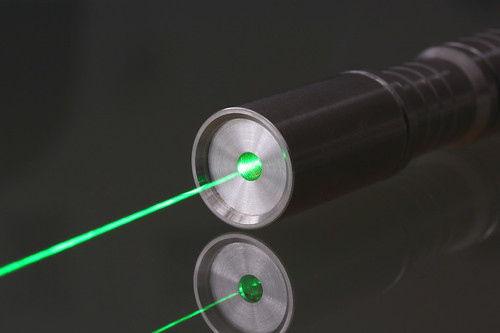
In search of the holy grail
Of 532nm DPSS modules, that is.
This quest has several variables; module type, size and finally, retailer. Size has already been covered, so we’ll move on to type. Well a DPSS is a DPSS is a DPSS… no, not quite. There are four main factors (imo) when “reviewing” a DPSS module:
Next up, divergence. Good vs. bad divergence is dependent on function. Do you want your cool new green lazor to reach the moon, or do you want it to light a match held 10cm in front of you? Everyone’s entitled to their own opinion, including yours truly. If I want to burn something, then I will reach for one of my trusty reds or BRs (Blu-Ray). What I want from my green is a seemingly never-ending beam that remains coherent as far as the eye can see… . So here’s the problem, as far as I have managed to ascertain with my own limited field-testing. Most Asian 532nm DPSS module wholesalers are leaning towards burning power and not good divergence. This means you get a pinpoint dot at around 20cm but consequently, you get a rather large & ugly blotch 10M away… not good. At least, not imo and hey, it’s my review… :na:
Finally, we have this all-mysterious property of Transverse Modes and mode-hopping – both terms which I am still trying to digest… You won’t know (or care) what TEM01 or mode-hopping really means until you see your lazor’s “dot” change shape… into like a figure eight…
You won’t know (or care) what TEM01 or mode-hopping really means until you see your lazor’s “dot” change shape… into like a figure eight…  The last thing I want to see is my module emitting not one, but two or more dots, arrrrgh :scowl:
The last thing I want to see is my module emitting not one, but two or more dots, arrrrgh :scowl:
Bring on the candidates
From L-R, a “classic” 60mm+, a “new”, DX-type 50mm+ and the 48mm “prototype” DPSS module.

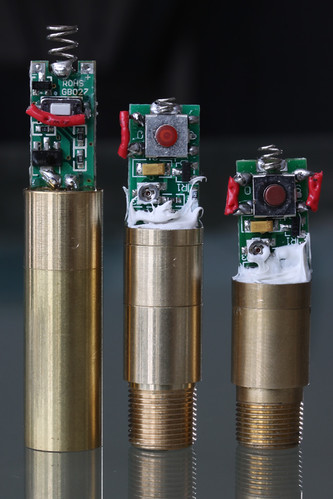
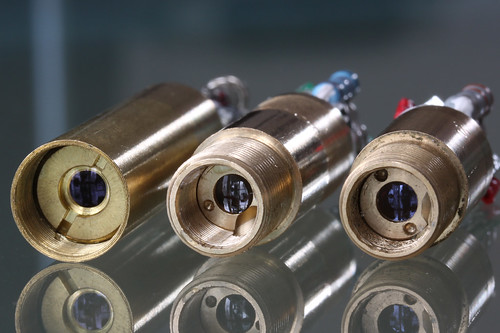
Yes, I’m personally responsible for those oddly-soldered red cables. Yes, you’re right in your assumption that I’m not an electronic engineer by trade. Or hobbyist, for that matter… Otherwise, what you see is what you get. Minus some spring length, which I cut off in order to wedge the last two candidates into my Mini Jay green. Before worrying about where I got them from, let’s talk about their qualities. Or lack thereof. The first, the “classic” module, happens to be the best of the bunch in terms of stability, divergence and even PO, for that matter. The second one, the DX-style module, loses to the former in all categories, however it is a stable module, does put out a reasonable amount of photons and most importantly, will fit very nicely into the Mini Jay Green (V 2.0 Retail)
Otherwise, what you see is what you get. Minus some spring length, which I cut off in order to wedge the last two candidates into my Mini Jay green. Before worrying about where I got them from, let’s talk about their qualities. Or lack thereof. The first, the “classic” module, happens to be the best of the bunch in terms of stability, divergence and even PO, for that matter. The second one, the DX-style module, loses to the former in all categories, however it is a stable module, does put out a reasonable amount of photons and most importantly, will fit very nicely into the Mini Jay Green (V 2.0 Retail)  Lastly, the prototype. The best thing about the prototype is that you can’t accidentally buy it. Which is only a problem if you like variable-powered, mode-hopping lazors…
Lastly, the prototype. The best thing about the prototype is that you can’t accidentally buy it. Which is only a problem if you like variable-powered, mode-hopping lazors… 
Having introduced the three modules, let’s have a look at their specs:
Module …………..… POmax ………….. POmin …………. Mrad (avg.*) …... Exit Dia*
“Classic”………….. 130mW ………... 128mW ……….… 1.6 ……….……...…. 1mm
DX-style …………. 125mW …………… 90mW* ………… 2.2 …...……..……. 1mm
Prototype ………. 100mW …………… 40mW* ………… >3 …...….…..……. 1mm
Ref LP* …………... 90mW ……………. 70mW* …….…. 0.6 …..………..……. 2mm
*Mrad is averaged as several measurement attempts came up with slightly different values. I measured from a distance of 0, 1, 3 and 6M and applied the formula (diameter delta / distance).
*POmin is based on either the PO dropping after ~20s and “captured” on the 45s mark, which is the max time I let the modules run. The figures are also highly dependent on the battery quality. Unlike the more sophisticated drivers incorporated in Red & BR builds, the PO of a “budget” DPSS module is directly proportional to the battery’s remaining charge. It is also possible to have “odd” batteries which show fully-charged (4.2V) on a DMM but are unable to power the module to it’s max output… .
*Ref LP, not pictured, is my first (and still best) 532nm laser.
*The "exit diameter" is my way of determining if the laser is burn-oriented or set for tight-divergence. Note the 0.6mrad LP has twice the exit diameter as the others... .
Clearly, I’d love to use the “classic” module in my Mini Jay Green but that’s not quite doable. No matter, this little puppy has a nice home in my Jaynom Kryton anyways The prototype would have been perfect for the “V1.0 RC”, which, imo, is my favorite of the two, but that module is complete junk and I have made the not-so-scientific assessment that all <50mm modules are going to be more of a miss than a hit... . Thus, the Goldilocks principle applies quite nicely here. Based on my limited experience, the DX-type module can make for a good partner to your Mini Jay Green kit (or any other small host) if you manage to find a good one, as I can easily imagine it’s much easier to acquire a bad one…
The prototype would have been perfect for the “V1.0 RC”, which, imo, is my favorite of the two, but that module is complete junk and I have made the not-so-scientific assessment that all <50mm modules are going to be more of a miss than a hit... . Thus, the Goldilocks principle applies quite nicely here. Based on my limited experience, the DX-type module can make for a good partner to your Mini Jay Green kit (or any other small host) if you manage to find a good one, as I can easily imagine it’s much easier to acquire a bad one…

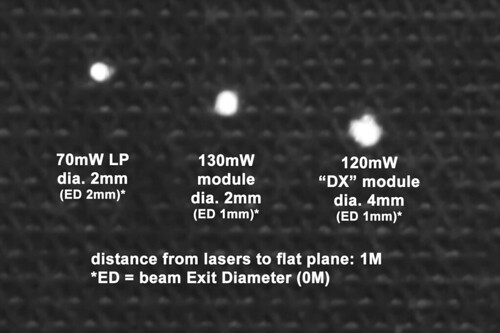
Where to buy
So now that we’ve got an idea what to use with our Mini Jay Green, the question is where to buy it. So here’s my take. If you go with Deal Extreme, you will find the cheapest price. Chances are you will not get the best module… . Although you can return it, it’s going to be nothing short of a headache and you will not be corresponding with anyone (afaik). Next option is one of our “residing” LPF colleagues and Asian retailers. The three that I have done business with are Susie from O-Like, Faona from Rayfoss and most recently, Merry from Laserlands. ALL THREE are very friendly, maintain close and personal communication with their customers and do honestly want their customers to be satisfied. Having said that, I have received average-quality products from them all. Although I have heard of success stories where a fellow colleague got a module that was stable and even exceeded the advertized specs, but SIX MODULES LATER, I cannot make such a claim, not even close. It has come to the point that if I get a stable module with half-way decent divergence which is within 75% of advertized PO, I am happy. Because the alternative has been way-underspeced / unstable / mode-hopping units.
So why even go this route? Because we are all on tight budgets and the alternative is quite a deal more expensive. Perhaps a “middle-of-the-road” solution is to go through a third-party provider such as OdicForce Lasers. Looking at their 80-100mW “DX-type” modules, my guess is that they are buying quantities from DX (or even directly from a wholesaler, for that matter) and “binning” the modules according to PO. They are [hopefully] removing the rejects (unstable, mode-hopping or otherwise bad) on the end-consumer’s behalf. Here is a quote from their website:
“Powercheck is designed to be an economical but useful test that allows us to sell a wide range of economical lasers with individual power readings. As part of the new shop design it will be possible for us to offer all lasers above 30mW as individually priced and tested lasers.”
The downside of course is that you will pay more for said module. Depending on the price on offer, you must decide what a good module is worth and/or if you are willing to risk going with non-tested modules and having to visit your local post office more than you want… .
In conclusion
I can easily recommend the Mini Jay Green kit (V 2.0 Retail) based on form and - assuming you have either some extra money or extra luck (re. obtaining a good module) - on function as well! Jay’s extremely impressive machining skills (talk about tight tolerances!), not to mention creativity in selecting and modding host after host, never ceases to amaze me. I have actually purchased machined parts from this man that I “may” use some day, that’s how much I respect his work, really! The host itself is really a nice piece and I even own the original LED version
I used to hate buying DPSS modules, but now it’s become sort of a hobby Despite all the headaches associated with the bad units, there’s nothing like the smile on your face when you land a golden sample, particularly at budget prices
Despite all the headaches associated with the bad units, there’s nothing like the smile on your face when you land a golden sample, particularly at budget prices  With our retailer friends on the Asian side of the equation constantly trying to improve their service, the future is looking better for all of us here at LPF. One example is the fact that Susie (O-Like) bought a very nice LPM in order to better support her customers. These “e-tailers” are not big business ventures and are trying to make their way in this community as best as they can. They are our “middlemen” when it comes to accessing the vast laser resources of the Asian optotronics industry and need to be seen as such, no more and no less. So although I’d really like to see improvement with their quality control, I do appreciate their excellent customer service and highly competitive pricing.
With our retailer friends on the Asian side of the equation constantly trying to improve their service, the future is looking better for all of us here at LPF. One example is the fact that Susie (O-Like) bought a very nice LPM in order to better support her customers. These “e-tailers” are not big business ventures and are trying to make their way in this community as best as they can. They are our “middlemen” when it comes to accessing the vast laser resources of the Asian optotronics industry and need to be seen as such, no more and no less. So although I’d really like to see improvement with their quality control, I do appreciate their excellent customer service and highly competitive pricing.
And now, for your gratuitous sex scene… err, I mean beam shot, as well as a few “proof-of-powah” shots!
Cheers :beer:
L-R, 130mW 1.5mrad "classic" (long) module,
Laserlands' "DX style" 120mW 2.2mrad module
& 70mW, 0.6mrad LP
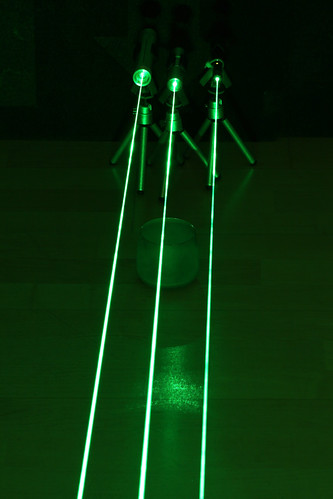
The Mini Jay Green in Action, using a fully-charged Ultrafire 3.6V CR2.
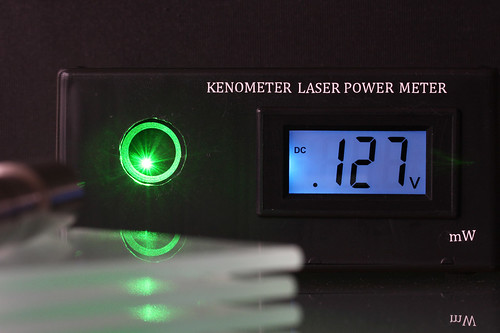
Just to prove that power source was no issue, the Laserland "DX-type" module
was also tested in my Kryton host with a 3.6V CR123A, just to rule out
any power source issues.
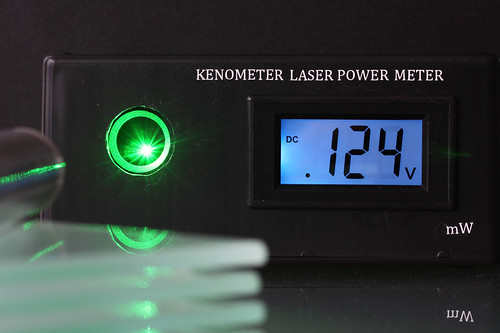
Here's a size comparison shot for everyone.
The squares are standard graph-paper 5x5cm.
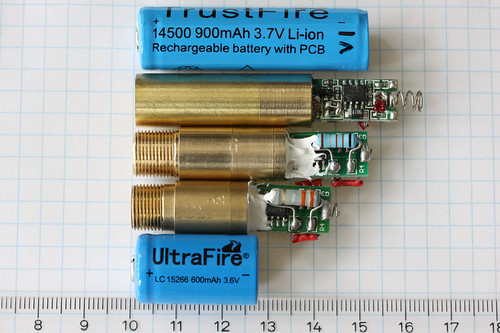
Like many of you here, I went gung-ho after seeing a green LP first-hand. At the time, I was pretty much bored with the trillions of <1mW red LPs so I hadn’t really thought about lasers in a long time. Of course, that’s before I discovered LPF and the fact that there were DIYers churning out 300mW reds, not to mention 200mW BRs! So naturally, my first >1mW laser was a green LP and also the basis of my first post here @LPF. Two ~200mW 405nm 6X and three ~300mW 660nm LCC/LOC lasers later and I’m still enchanted by that same green glow that got me into this hobby in the first place
Intro
I don’t know why, exactly, but if a Laser doesn’t fit in my pocket (figuratively speaking), then I’m not all that interested. Having said that, my "Jaynom" Kryton Green is the biggest laser I own atm and I’m always eyeing the smaller builds here at LPF. Thus, as exceptional as they may be, I’m not into “RPL”–like handhelds as much as Dorcy Jr. / Romisen – Ultrafire builds. So of course my eyes lit up when Jay posted his latest build (at that time), his “mini” green kit:

Forget Obi-wan, Jay's the master here
Without a doubt, Jay (aka JayRob, aka badBoyOnBigBlackBike, aka...) is one of the key members of LPF. His contributions, both in Lazor "kits" as well as Lazor-knowhow are just to numerous to mention :beer: For example, the heatsink pictured above, which fits the stainless steel Ultrafire host so perfectly that its really got you :thinking:, is only half of the story. Jay has literally re-bored the host to accommodate the non-standard CR2 battery (standard for said host being a AA or 14500 Li-ion equivalent). I’m not a machinist, but I’ve had the opportunity to mess around with a lathe and it’s harder than it looks - and that was with Aluminum, never mind stainless steel!!! So needless to say, there’s really quite a bit of effort, not to mention experience behind this kit and well worth Jay’s asking price. Did I mention that it’s an awesome-looking host?

Or, in Jay's words, "schweet!"
(...interesting choice of words, for a badBoyOnBigBlackBike...)

What size module did you say?
Oh well, if it was that easy, Jay wouldn’t be interested. He’s a man always looking for a challenge, be it on his bike or his lathe. In order to make use of the original mini green kit (V1.0 RC), one needed to shorten the typical 65mm green DPSS module. “Ah… Jay, it’s like made of brass, eh…”. So I knew right off the bat this was going to be an “advanced” kit and maybe out of my reach… . Fortunately for me, I was right in the middle of my search for the ultimate budget 532nm DPSS module… .Which is when my “research partner”, Faona of RayFoss, informed me of a 50mm module she came across. “50mm, that’s perfect, ship it on over!!!”
And yes, the fit was just right, but apparently there’s so much one can manage, with a uh, smaller “module”… (so forget that b.s. about the motion-of-the-ocean your first GF told you – she was just being polite…

In search of the holy grail
Of 532nm DPSS modules, that is.
This quest has several variables; module type, size and finally, retailer. Size has already been covered, so we’ll move on to type. Well a DPSS is a DPSS is a DPSS… no, not quite. There are four main factors (imo) when “reviewing” a DPSS module:
- power output PO (including topic of IR percentage)
- Beam divergence
- Beam quality (Transverse mode, etc.)
- Driver stability
Next up, divergence. Good vs. bad divergence is dependent on function. Do you want your cool new green lazor to reach the moon, or do you want it to light a match held 10cm in front of you? Everyone’s entitled to their own opinion, including yours truly. If I want to burn something, then I will reach for one of my trusty reds or BRs (Blu-Ray). What I want from my green is a seemingly never-ending beam that remains coherent as far as the eye can see… . So here’s the problem, as far as I have managed to ascertain with my own limited field-testing. Most Asian 532nm DPSS module wholesalers are leaning towards burning power and not good divergence. This means you get a pinpoint dot at around 20cm but consequently, you get a rather large & ugly blotch 10M away… not good. At least, not imo and hey, it’s my review… :na:
Finally, we have this all-mysterious property of Transverse Modes and mode-hopping – both terms which I am still trying to digest…
Bring on the candidates
From L-R, a “classic” 60mm+, a “new”, DX-type 50mm+ and the 48mm “prototype” DPSS module.



Yes, I’m personally responsible for those oddly-soldered red cables. Yes, you’re right in your assumption that I’m not an electronic engineer by trade. Or hobbyist, for that matter…
Having introduced the three modules, let’s have a look at their specs:
Module …………..… POmax ………….. POmin …………. Mrad (avg.*) …... Exit Dia*
“Classic”………….. 130mW ………... 128mW ……….… 1.6 ……….……...…. 1mm
DX-style …………. 125mW …………… 90mW* ………… 2.2 …...……..……. 1mm
Prototype ………. 100mW …………… 40mW* ………… >3 …...….…..……. 1mm
Ref LP* …………... 90mW ……………. 70mW* …….…. 0.6 …..………..……. 2mm
*Mrad is averaged as several measurement attempts came up with slightly different values. I measured from a distance of 0, 1, 3 and 6M and applied the formula (diameter delta / distance).
*POmin is based on either the PO dropping after ~20s and “captured” on the 45s mark, which is the max time I let the modules run. The figures are also highly dependent on the battery quality. Unlike the more sophisticated drivers incorporated in Red & BR builds, the PO of a “budget” DPSS module is directly proportional to the battery’s remaining charge. It is also possible to have “odd” batteries which show fully-charged (4.2V) on a DMM but are unable to power the module to it’s max output… .
*Ref LP, not pictured, is my first (and still best) 532nm laser.
*The "exit diameter" is my way of determining if the laser is burn-oriented or set for tight-divergence. Note the 0.6mrad LP has twice the exit diameter as the others... .
Clearly, I’d love to use the “classic” module in my Mini Jay Green but that’s not quite doable. No matter, this little puppy has a nice home in my Jaynom Kryton anyways


Where to buy
So now that we’ve got an idea what to use with our Mini Jay Green, the question is where to buy it. So here’s my take. If you go with Deal Extreme, you will find the cheapest price. Chances are you will not get the best module… . Although you can return it, it’s going to be nothing short of a headache and you will not be corresponding with anyone (afaik). Next option is one of our “residing” LPF colleagues and Asian retailers. The three that I have done business with are Susie from O-Like, Faona from Rayfoss and most recently, Merry from Laserlands. ALL THREE are very friendly, maintain close and personal communication with their customers and do honestly want their customers to be satisfied. Having said that, I have received average-quality products from them all. Although I have heard of success stories where a fellow colleague got a module that was stable and even exceeded the advertized specs, but SIX MODULES LATER, I cannot make such a claim, not even close. It has come to the point that if I get a stable module with half-way decent divergence which is within 75% of advertized PO, I am happy. Because the alternative has been way-underspeced / unstable / mode-hopping units.
So why even go this route? Because we are all on tight budgets and the alternative is quite a deal more expensive. Perhaps a “middle-of-the-road” solution is to go through a third-party provider such as OdicForce Lasers. Looking at their 80-100mW “DX-type” modules, my guess is that they are buying quantities from DX (or even directly from a wholesaler, for that matter) and “binning” the modules according to PO. They are [hopefully] removing the rejects (unstable, mode-hopping or otherwise bad) on the end-consumer’s behalf. Here is a quote from their website:
“Powercheck is designed to be an economical but useful test that allows us to sell a wide range of economical lasers with individual power readings. As part of the new shop design it will be possible for us to offer all lasers above 30mW as individually priced and tested lasers.”
The downside of course is that you will pay more for said module. Depending on the price on offer, you must decide what a good module is worth and/or if you are willing to risk going with non-tested modules and having to visit your local post office more than you want… .
In conclusion
I can easily recommend the Mini Jay Green kit (V 2.0 Retail) based on form and - assuming you have either some extra money or extra luck (re. obtaining a good module) - on function as well! Jay’s extremely impressive machining skills (talk about tight tolerances!), not to mention creativity in selecting and modding host after host, never ceases to amaze me. I have actually purchased machined parts from this man that I “may” use some day, that’s how much I respect his work, really! The host itself is really a nice piece and I even own the original LED version
I used to hate buying DPSS modules, but now it’s become sort of a hobby
And now, for your gratuitous sex scene… err, I mean beam shot, as well as a few “proof-of-powah” shots!
Cheers :beer:
L-R, 130mW 1.5mrad "classic" (long) module,
Laserlands' "DX style" 120mW 2.2mrad module
& 70mW, 0.6mrad LP

The Mini Jay Green in Action, using a fully-charged Ultrafire 3.6V CR2.

Just to prove that power source was no issue, the Laserland "DX-type" module
was also tested in my Kryton host with a 3.6V CR123A, just to rule out
any power source issues.

Here's a size comparison shot for everyone.
The squares are standard graph-paper 5x5cm.

Last edited:




